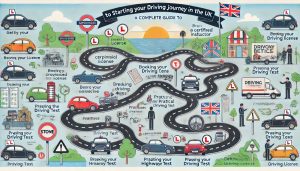 Learner Drivers: A Complete Guide to Starting Your Driving Journey in the UK
Learner Drivers: A Complete Guide to Starting Your Driving Journey in the UK
Becoming a driver is one of life’s most exciting milestones, and if you’re a learner driver in the UK, you’re probably eager to hit the road with confidence. But where do you start? From applying for your provisional licence to preparing for the driving test, here’s everything you need to know as a learner driver.
What Is a Learner Driver?
A learner driver is someone who is in the process of learning to drive but hasn’t yet passed their practical driving test. You’ll need a provisional licence, driving lessons with a qualified instructor or supervising driver, and plenty of practice before you can qualify for a full licence.
Step 1: Apply for Your Provisional Licence
Before you get behind the wheel, you must have a provisional licence. You can apply online through the DVLA website. You’ll need this licence for both your lessons and tests, so apply early to avoid delays.
Step 2: Book Driving Lessons
Choosing the right instructor is key. Look for a DVSA-approved driving instructor (ADI) with positive reviews. Consistency is important, so try to book 1–2 lessons per week with a Chelsea driving instructor, to keep your progress steady.
Step 3: Practise with a Supervising Driver
In addition to professional lessons, you can practise in a car with:
-
A qualified driver aged 21 or older.
-
Someone who has held a full UK driving licence for at least three years.
You’ll also need the car to be insured for learner drivers and display L-plates clearly on the front and back.
Step 4: Prepare for the Theory Test
Every learner must pass the theory test before booking the practical. It includes:
-
Multiple-choice questions.
-
A hazard perception test using video clips.
Revision apps and practice tests are a great way to prepare and build confidence.
Step 5: Build Experience in All Conditions
Don’t just drive in perfect conditions. As a learner, it’s important to gain experience in:
-
Busy city roads.
-
Motorways (with an ADI in a dual-controlled car).
-
Night-time driving.
-
Bad weather.
This variety will make you a safer driver and better prepared for the test.
Step 6: Learn the Manoeuvres
Your instructor will teach you essential manoeuvres such as:
-
Parallel parking.
-
Bay parking.
-
Pulling up on the right and reversing.
-
Emergency stop.
These are often tested, so practise until you’re confident.
Step 7: Book Your Practical Driving Test
Once your instructor feels you’re ready, you can book your practical test. The examiner will assess:
-
General driving ability.
-
Manoeuvres.
-
Independent driving (following road signs or sat nav directions).
Remember: minor faults are allowed as long as they don’t compromise safety.
Tips for Learner Drivers
-
Be patient – progress takes time.
-
Ask questions – your instructor is there to help.
-
Stay positive – mistakes are part of learning.
-
Practise regularly – the more time on the road, the better.
